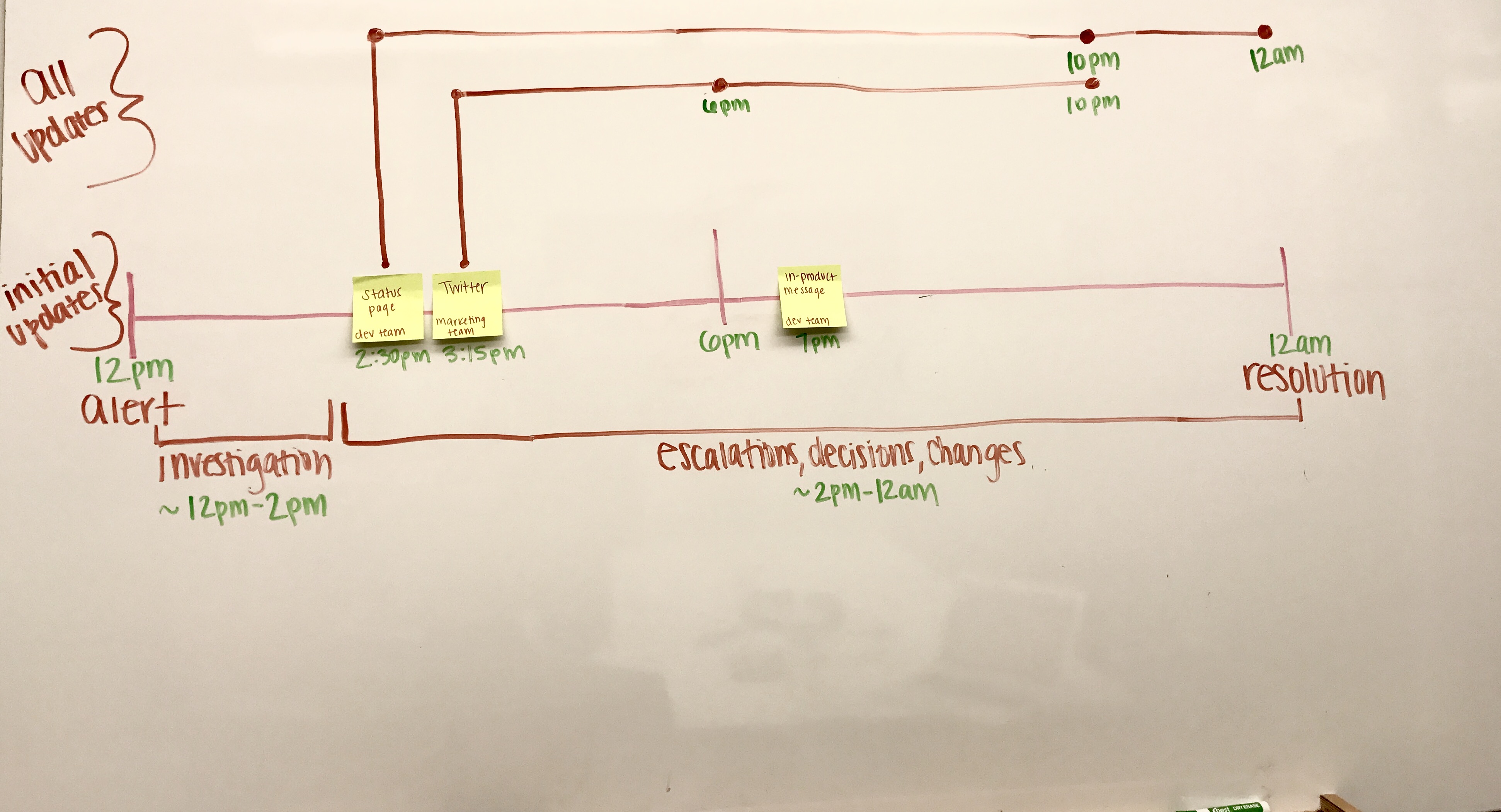Communicatie bij incidentrespons
Een goede incidentrespons betekent niet alleen dat het probleem moet worden opgelost, maar ook dat we transparant moeten zijn tegenover klanten.
GEBRUIK DIT SPEL OM...
Te zien waar je incidentcommunicatie tekortschiet.
Een beter communicatieplan op te stellen voor gebruik bij toekomstige incidenten.
Als je worstelt met of op je gezondheidsmonitor, kan dit spelletje jullie op weg helpen.

Mensen
4 tot 10

Voorbereidingstijd
45 tot 60 min.

Tijd
60 min.

Moeilijkheidsgraad
Gemiddeld
Het spel spelen
Speel dit spel als jullie minstens één incident hebt gehad waarbij veel met klanten is gecommuniceerd. Speel het spelletje opnieuw na het volgende incident. Zo kunnen jullie zien of het proces is verbeterd.
Materiaal
Whiteboard of presentatiebord
Markers
Post-its
Voorbereiden
Beschrijf een recent incident (20 min.)
Kies een recent incident dat meer dan twee uur duurde, dat pijnlijk was voor je klanten en waarbij communicatie met klanten kwam kijken.
Beantwoord de volgende vragen over het incident:
- Wanneer begon het incident?(Misschien kun je dit controleren in je controle-/waarschuwingstools)
- Tot hoe laat duurde het incident?
- Hoelang duurde de onderzoeksfase voor dit incident?
- Hoelang duurde de escalatie-, beslissings- of veranderingsfase van dit incident?
- Wat merkten je klanten aan je product waardoor ze wisten dat er een probleem was? (Bij het inloggen kwamen klanten terecht op een pagina met de fout 'Er is iet misgegaan', waar ze werden omgeleid naar onze ondersteuningsportal). Als je hier een schermafbeelding van hebt, houd die dan bij de hand op je laptop om die tijdens het spel te laten zien of druk de afbeelding af.
- Welke berichten zijn er tijdens en na het incident verstuurd?
- Via welk medium zijn de berichten verzonden? (Dit kunnen sociale mediakanalen zijn, een servicedesk, een statuspagina, e-mail, postduiven, enz. Je weet wat we bedoelen.)
- Wie heeft welke berichten gestuurd?
- Op welke tijd(en) is elk bericht verzonden?
Maak een tijdlijn (10 min.)
Kom 5 tot 10 minuten eerder naar de sessie (zorg ervoor dat je de ruimte reserveert!). Teken een tijdlijn voor incidenten op een whiteboard of presentatiebord met de begintijd van het incident en de eindtijd van het incident (als het goed is opgelost). Je kunt het zo eenvoudig of complex maken als je wilt!
eerste waarschuwing --------------------------------------------------- oplossing
Ga terug naar de vragen die je hierboven hebt beantwoord en gebruik post-its om de tijdlijn in te vullen met tijden en kanalen die zijn gebruikt voor communicatie met klanten tijdens het incident.
Als een kanaal meer dan één keer is gebruikt, teken dan een vertakking en zet een punt voor elke keer dat het kanaal is gebruikt.

BIJVOORBEELD...
De tijdlijn voor communicatie bij incidentrespons ziet er ongeveer zo uit.

Tip:
Deel na de sessie je geleerde lessen met zoveel mogelijk leeftijdsgenoten, collega's en vrienden. Deel de dingen die je geleerd hebt met zoveel mogelijk leeftijdsgenoten, collega's en vrienden. Vraag ook wat zij hebben geleerd. Het is een geschenk waar we steeds opnieuw van profiteren!
Stap 1
Schets de situatie (10 min.)
Begin de sessie met een beschrijving van het incident waarop je de focus wilt leggen. Laat de tijdlijn zien die je hebt gemaakt en vraag de deelnemers om de tijdlijn te doorlopen op basis van wat je hebt getekend en wat ze zich kunnen herinneren van het incident.Voeg alle vergeten kanalen of communicatie toe.
Benadruk dat dit een veilige plek is waar deelnemers open kunnen zijn over frustraties, verwarring, meningsverschillen, enz.
Stap 2
Bepaal de tussenperioden (10 min.)
Noteer de intervallen in je communicatietijdlijn.
- Tijd tussen het begin van het incident/de eerste waarschuwing en de eerste update: x minuten/uur
- Tijd tussen de eerste update en de tweede update: x minuten/uur
- Tijd tussen tweede update en derde update: x minuten/uur
- Tijd tussen de derde update (of de hoeveelste update de laatste update vóór de oplossing is) en de update van de oplossing: x minuten/uur
Markeer de grootste hiaten door het gebied of de gebieden te omcirkelen met een stift.

Tip:
We vinden het belangrijk om vroeg te communiceren (zodra een probleem met klanten wordt ontdekt) en vaak (geef elke 20-30 minuten een update tot het is opgelost). Is de tijd tussen deze updates langer? Dan kan dat voor deze oefening worden beschouwd als een hiaat.
Stap 3
Evaluatie van de communicatie (15 min.)
Vraag de deelnemers om problematische hiaten, verwarring en soortgelijke problemen met de communicatie met je klanten tijdens het incident op post-its op te schrijven. Als jullie niet meer verder komen, gebruik dan de aanwijzingen hieronder.
- Waar hebben we klanten naartoe gestuurd toen ze op de foutpagina kwamen? Is dit een typische klantenstroom als er een fout is opgetreden bij je product/systeem?
- Hoe zou jij je als klant hebben gevoeld als je een soortgelijk probleem tegenkwam?
- Hebben we vroeg en vaak met klanten gecommuniceerd? (je hiaten vanaf stap 2 zouden dit moeten beantwoorden) Waarom wel of niet?
- Hoe hebben we bepaald wie met klanten communiceert?
- Hebben we met de juiste klanten gecommuniceerd? Hoe weten we dat?
- Waren de gebruikte media/kanalen gemakkelijk toegankelijk/zichtbaar voor klanten? Hoe wisten ze waar ze het konden vinden?
- Hebben de berichten die we stuurden ervoor gezorgd dat klanten minder behoefte hadden om contact op te nemen met ons ondersteuningsteam?
- Wat weten onze klanten nu over dit incident puur op basis van de berichten die we tijdens/na het incident hebben gestuurd?
Stap 4
Analyse van de hoofdoorzaken (15 min.)
Laat elke deelnemer naar voren komen en hun 'probleem' op de tijdlijn plakken. Laat ze kort beschrijven wat ze hebben opgeschreven en bespreek als groep waarom je denkt dat dat probleem zich voordeed. Met andere woorden, wat was de hoofdoorzaak van dat probleem in je communicatieproces voor incidenten?
Voorbeeld:
- Probleem: tijdens ons incident hebben we klanten meer dan 4 uur niet op de hoogte gebracht.
- Hoofdoorzaak: we kregen in die 4 uur geen update van het ontwikkelteam, dus we wisten niet wat we tegen klanten moesten zeggen.

Tip:
Als je problemen hebt om de hoofdoorzaak van de problemen die je hebt genoemd te achterhalen, speel dan ons spel 5 keer waarom.
Stap 4
Stel een plan op (10 min.)
Kies als groep 2-3 kwesties met een hoge prioriteit om aan te pakken op basis van de analyse van de hoofdoorzaak die je zojuist hebt gedaan. Maak een actie-plan, inclusief verantwoordelijken en deadlines.
Bijvoorbeeld:
| Hoofdoorzaak van het hiaat | Aanbeveling om in te vullen |
|---|---|
| We wisten nog niet wat het probleem was, dus konden we onze klanten niets zinnigs vertellen. | Zelfs een vage update zoals 'het spijt ons zeer voor de overlast die dit heeft veroorzaakt en we onderzoeken het probleem met spoed'. Of 'we zijn nog steeds bezig met probleem X.Over 30 minuten sturen we je een update.' is veel beter dan zwijgen. |
| Niemand nam de verantwoordelijkheid om informatie door te geven aan klanten | Definieer de rollen voor incidentcommunicatie duidelijk, zodat de volgende keer dat een incident zich voordoet duidelijk is wie welke verantwoordelijkheid heeft. |
| We wisten niet wat we moesten zeggen of hoe we het moesten zeggen. | Stel sjablonen op voor veelvoorkomende incidenten of maak een toon-/stijlgids voor incidentupdates die je team makkelijk en eenvoudig kan raadplegen tijdens de chaos van een incident. |
| We hebben als team geen overeenstemming bereikt over een consistent communicatieplan voor incidenten | Gebruik dit handige sjabloon om een communicatieplan voor incidenten op te stellen. |
| We hebben geen commandostructuur voor wie incidentcommunicatie afhandelt, iets wat we wel hebben voor wie het incident oplost. | Gebruik dit handige sjabloon om de rollen, verantwoordelijkheden en escalaties van incidentcommunicatie te bepalen. |

Antipatroon
Schrijf geen actie-items op met de gedachte om het spel zo snel mogelijk af te ronden. Documenteer een plan alleen als je team er graag aan werkt.
Is het gelukt?
Organiseer een volledige gezondheidsmonitorsessie of stel een controlemoment in om samen met je team te zien of er verbetering is.
En nu…
Deel je actie-items met je team/organisatie, zodat iedereen op de hoogte is van het communicatieproces voor incidenten.
Na het volgende incident kun je dit spelletje opnieuw spelen om te zien hoe je nieuwe communicatieproces in het echt is verlopen. Het idee is om het proces voortdurend te verfijnen en te verbeteren, totdat je een zo goed mogelijk communicatieplan hebt.
Wil je nog meer draaiboeken?
Laat hieronder je e-mailadres achter om op de hoogte te blijven van nieuwe gezondheidsmonitoren en spellen.
Kreeg u Feedback?
Stel een vraag of plaats een opmerking op de website van de Atlassian Community.
.jpg?cdnVersion=3145)